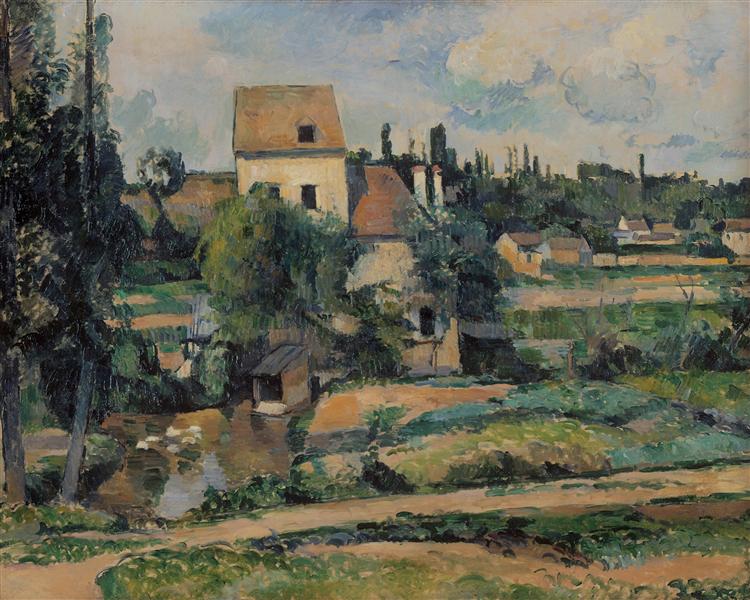Beschreibung
Paul Cézanne's Moulin De La Couleuvre At Pontoise, painted in 1881, is a masterful depiction of the French landscape that sits at the crossroads of tradition and modernity. At a critical moment in his artistic practice, Cézanne turned to exploring nature through the lens of structured composition and innovative use of color that would pave the way for modern art. This particular painting invites us to immerse ourselves in a scene of rural tranquility, where nature and human intervention are harmoniously intertwined.
The work features a traditional mill, which stands as the focal point, amidst a natural setting that offers a rich display of vegetation and sky. The arrangement of the mill and the adjacent trees reveal a dynamic grouping that showcases Cézanne’s mastery in organizing elements on the canvas. Each element is carefully placed, creating a sense of balance and stability. The mill, robust and solid, contrasts with the lightness of the trees surrounding it, thus providing a dialogue between the structured and the organic.
The use of color in this work is particularly notable. Cézanne employs a palette that highlights vibrant, earthy greens, which bring the scene to life and suggest an intimate connection with nature. The sky, painted in shades of blue and white, complements the richness of the vegetation, adding depth and luminosity. The technique of short, visible brushstrokes is characteristic of Cézanne's post-impressionist style, which seeks to capture the essence of the object rather than its literal representation. This technique also allows for an emotional intensity that evokes an almost tactile experience of the landscape, inviting the viewer to feel the fresh air and sounds of the countryside.
Although the painting does not predominantly feature human figures, the windmill itself suggests the presence of life in the rural area. Its silhouette implies activity, memory and tradition, a bridge between men and their environment. This is a recurring characteristic of Cézanne's work: his ability to evoke life through the representation of landscapes that bear the imprint of human intervention.
The choice of Pontoise as a place of inspiration is significant, as the town was a major centre for artists in the 19th century, where he met other masters such as Camille Pissarro. However, in Cézanne’s interpretation, the landscape takes on an individuality that goes beyond simply capturing a place; by transforming his immediate surroundings, the artist infuses each brushstroke with a sense of time and place that resonates with the viewer.
In the context of Cézanne's artistic development, "Moulin De La Couleuvre At Pontoise" represents not only a milestone in his exploration of landscape, but also a stage in art history that led him to be a precursor of movements such as Cubism. The work challenges traditional perspective, turning nature into a visual puzzle that insists on a new way of seeing and experiencing the world.
In conclusion, this painting not only captures an idyllic corner of the French countryside, but also acts as a testament to Cézanne’s creative process and his transformation of the natural landscape into an enriching visual experience. The fusion of form, colour and content invites viewers to reflect on the relationship between man and nature, a timeless theme that remains relevant in contemporary art. The work is a record of an era, a locality and a master whose vision remains deeply influential.
KUADROS ©, a famous painting on your wall.
Hand-made oil painting reproductions, with the quality of professional artists and the distinctive seal of KUADROS ©.
Painting reproduction service with satisfaction guarantee. If you are not completely satisfied with the replica of your painting, we will refund 100% of your money.

